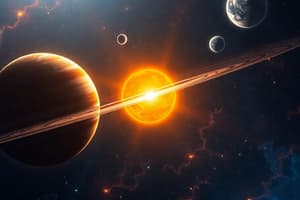Podcast
Questions and Answers
Mercury is the ______ planet in our solar system.
Mercury is the ______ planet in our solar system.
smallest
Mercury is a ______ and rocky planet.
Mercury is a ______ and rocky planet.
grey
Mercury doesn't have any ______.
Mercury doesn't have any ______.
moons
Earth is the only planet to support ______.
Earth is the only planet to support ______.
Mars is a ______-orange colour.
Mars is a ______-orange colour.
Saturn is ______ yellow.
Saturn is ______ yellow.
Saturn is famous for its thousands of ______ rings.
Saturn is famous for its thousands of ______ rings.
Venus has got ______ yellow clouds.
Venus has got ______ yellow clouds.
Neptune has winds that travel at ______ km per hour!
Neptune has winds that travel at ______ km per hour!
Flashcards
Mercury
Mercury
The smallest and nearest planet to the Sun, grey and rocky.
Earth
Earth
The planet that supports life, light blue with clouds, has one moon.
Mars
Mars
A small, rocky, lifeless planet known for its red-orange color and two moons.
Saturn
Saturn
Signup and view all the flashcards
Jupiter
Jupiter
Signup and view all the flashcards
Neptune
Neptune
Signup and view all the flashcards
Venus
Venus
Signup and view all the flashcards
Orbit
Orbit
Signup and view all the flashcards
Dwarf Planet
Dwarf Planet
Signup and view all the flashcards
Study Notes
Planets in Our Solar System
- Mercury: Smallest planet, closest to the Sun, grey and rocky, no moons.
- Earth: Rocky planet, supports life, light blue with white clouds, one moon.
- Mars: Red-orange, rocky, lifeless, two moons (Phobos and Deimos).
- Saturn: Pale yellow, famous for thousands of bright rings, 53 known moons.
- Eight Major Planets: Mercury, Venus, Earth, Mars, Jupiter, Saturn, Uranus, Neptune.
- Dwarf Planets: Objects orbiting the Sun, smaller than major planets (Pluto is one example; more exist).
- Orbits & Time: Planets orbit the Sun at different speeds; Earth takes one year to orbit the Sun.The Earth's moon takes less than 28 days to travel around the Earth.
- Jupiter's Size: 318 times larger than Earth.
- Neptune's Winds: Winds travel at 2000 km per hour.
- Venus's Clouds: Poisonous yellow clouds.
- New Discoveries: New moons are frequently found around planets like Jupiter, Saturn, Uranus, and Neptune.
Studying That Suits You
Use AI to generate personalized quizzes and flashcards to suit your learning preferences.




